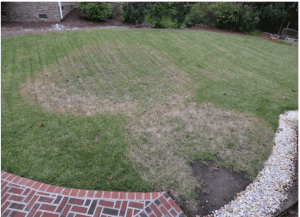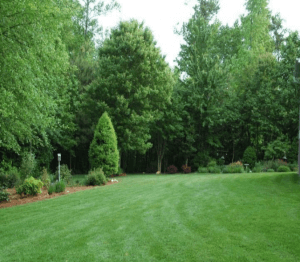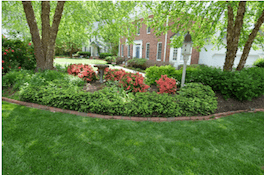Large Patch Fungus Late September starts the Large Patch fungus season on Zoysia, Bermuda, Centipede and St. Augustine. Fairway Green is seeing more cases of this disease every year in our area. Large Patch Fungus is a damaging disease on Zoysia, Bermuda, Centipede and St. Augustine turf in the fall and early spring. This disease… Read more »

Large Patch Fungus in Zoysia
Late September starts the Large Patch fungus season on Zoysia, Bermuda, Centipede and St. Augustine. Fairway Green is seeing more cases of this disease every year in our area. Large Patch Fungus is a damaging disease on Zoysia, Bermuda, Centipede and St. Augustine turf in the fall and early spring. This disease is similar to Brown Patch Fungus on Fescue. Large Patch Fungus needs to be controlled with two applications of fungicide in the fall when ground temperatures are between 50 and 70 degrees. Damage occurs before you are aware you have it and is not visible until green-up in the spring. Preventative Fungicide in the fall and early spring are the only way to control this disease.

Southern Perfection Turf
Fairway Green uses and offers to customers and non-customers its very own hand-selected turf-type tall fescue mixture: Southern Perfection. Fairway Green’s Southern Perfection contains a mixture of 35% Falcon IV, 30% Tribute II, 30% Renegade DT and 2% Rockstar Kentucky Bluegrass. It is turfgrass for the next century. It wins the fight against surface-feeding insects, grows low but grows strong, your lawn will never be greenerand it naturally cuts down on clippings and mowing. Falcon IV, Tribute II and Renegade DT are the best tall fescue varieties available in the industry. Tested across multiple states, locations and environments these varieties exhibit improved turf quality, vibrant turf color, excellent disease resistance and improved stress tolerance. Rockstar Kentucky bluegrass is the fastest establishing elite Kentucky bluegrass available in the lawn care industry. Looking for elite turf, fast germination and enhanced knitting of turf for improved sod strength and traffic tolerance? Look no further than Rockstar. In addition to all these great qualities, Southern Perfection contains 0% weed seed and 0% other crop seed.
Southern Perfection is now Water Star® qualified by the Turfgrass Water Conservation Alliance (TWCA). Visit Turfgrass Water Conservation Alliance for additional information about this exciting program.
Fairway Green wanted to remind everyone that we still have an armyworm threat this month. We have seen several cases in the past two weeks. Armyworms lay eggs on structures like homes, trees and shrubs. Eggs hatch as larva, drop to the ground and start feeding heavily on healthy actively growing turf for about two to three weeks. After feeding and damaging the turf, they will bury in the ground and pupate. This life cycle continues till October/November. North Carolina could see two to four generations of fall armyworms. It is thought that they do not survive winter months in North Carolina.
Visit HERE for additional information.

Ornamental Shrubs
Planting ornamentals in the fall allows the plants to establish with less stress from heat and drought conditions. Ornamentals typically do not need watering every day after planting from a pot. A good rule of thumb would be every three days without natural rainfall. Over watering can promote root funguses which are deadly to the tree or shrub. Before planting, review recommended planting depths, locations and special soil or pH requirements. Be sure to not plant too deep. This is a common problem and will eventually cause permanent damage to the tree or shrub

Core Aeration Seeding
If you live in the Transitional Zone, chances are you will have to seed your Fescue lawn every year or at least every other year. Tall Fescue in this zone faces many challenges during the year that can create turf damage or injury. Diseases can be one of the causes for turf damage. Brown Patch Fungus, Dollar Spot and Pythium can be devastating to fescue. Then we experience a couple months of air and ground temperatures that are too high for plant growth and survival. Extended dry periods along with the heat make for a damaging combination on all turf types. In fact, when the ground temperatures reach the upper 80 degrees to low 90 degrees, cool season grasses root system stops developing and will lose root mass that supports plant survival.
We are now in the fall grub cycle where they can cause major damage if not caught early. There are several beetles that produce the grubs we see while digging in our lawns and natural areas. Grub species in North Carolina include Southern and Northern Chafer, Japanese, Asiatic, Green June and the May beetle. Grubs are identified by their cream off white colored body and off brown color hind part and head. Grubs have six legs and are from ¼ to 1½ inches. They are often seen in their C-shaped position in the soil.
White grubs create damage in turf by eating the root system of the host plant. Turf damage is usually observed in late spring through fall with an off color wilting appearance. Many times it is misdiagnosed as disease, heat or dry stress. The lawn may have a spongy almost loose feel to the soil under the turf. In severe cases, the turf may roll up when tugged on from the lack of roots holding it to the soil. Activity from birds, raccoons, skunks and moles could indicate a grub infestation. To determine the extent of grub activity and the need for control, you will need to use a spade to remove the upper 3 inches of soil in a 12” x 12” area. Cut back the turf sample to count the number of grubs and inspect root damage. If nine or more grubs are observed, take immediate action utilizing proper products. All turf types are susceptible to grub feeding and damage.
In our continued effort to improve and deliver the best possible turf and ornamental management service, we will be moving to a more efficient method of communication. Fairway Green will be implementing an email/text notification system in the coming months. The notification will be used for invoicing after service, important alerts pertaining to your lawn and contact before service for customers. This new notification system will help us service your lawn in the most efficient and effective way possible.
Please help make this transition as smooth as possible and update/correct your cell number and email addresses in our system.